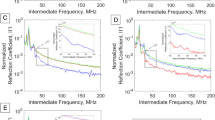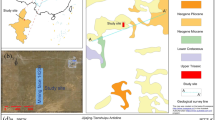Abstract
Underground Coal Gasification (UCG) produces less surface impact, atmospheric pollutants and greenhouse gas than traditional surface mining and combustion. Therefore, it may be useful in mitigating global change caused by anthropogenic activities. Careful monitoring of the UCG process is essential in minimizing environmental impact. Here we first summarize monitoring methods that have been used in previous UCG field trials. We then discuss in more detail a number of promising advanced geophysical techniques. These methods – seismic, electromagnetic, and remote sensing techniques – may provide improved and cost-effective ways to image both the subsurface cavity growth and surface subsidence effects. Active and passive seismic data have the promise to monitor the burn front, cavity growth, and observe cavity collapse events. Electrical resistance tomography (ERT) produces near real time tomographic images autonomously, monitors the burn front and images the cavity using low-cost sensors, typically running within boreholes. Interferometric synthetic aperture radar (InSAR) is a remote sensing technique that has the capability to monitor surface subsidence over the wide area of a commercial-scale UCG operation at a low cost. It may be possible to infer cavity geometry from InSAR (or other surface topography) data using geomechanical modeling. The expected signals from these monitoring methods are described along with interpretive modeling for typical UCG cavities. They are illustrated using field results from UCG trials and other relevant subsurface operations.










Similar content being viewed by others
References
Blinderman MS, Fidler S (2003) Groundwater at the underground coal gasification site at Chinchilla, Australia. Water in Mining Conference, Brisbane
Britten JA, Thorsness CB (1989) A model for cavity growth and resource recovery during underground coal gasification. In Situ 13:1–53
Burton E, Friedmann J, Upadhye R (2007) Best practices in underground coal gasification. Lawrence Livermore National Laboratory, Livermore
Cao L, Zhang Y, He J, Liu G, Yue H, Wang R, Ge L (2008) Coal mine land subsidence Monitoring by using Spaceborne INSAR data - a case study in Fengfeng, Hebei Province, China, The International Archives of the Photogrammetry, Remote Sensing and Spatial Information Sciences. Vol. XXXVII. Part B8. Beijing 2008
Couch G (2009) Underground coal gasification. International Energy Agency Coal Research, London
Curlander J, McDonough R (1991) Synthetic aperture radar systems and signal processing. John Wiley & Sons, New York
Daily W, Ramirez A, LaBrecque D, Nitao J (1992) Electrical resistivity tomography of vadose water movement. Water Resour Res 28(5):1429–1442
Duba A, Davis DT, Laine EF, Lytle RJ (1978) Geotomography and coal gasification, LLNL UCRL- 81923
Gregg DR (1977) Ground subsidence resulting from underground coal gasification, LLNL Report UCRL-52255
LaBrecque DJ, Yang X (2001) Difference inversion of electrical resistivity tomography (ERT) data - a fast inversion method for 3-D in-situ monitoring. J Environ Eng Geophys 6(2):83–89
Lu Z, Wicks C (2010) Characterizing 6 August 2007 Crandall Canyon mine collapse from ALOS PALSAR InSAR. Geom Hazards Risk 1(1):85–93. doi:10.1080/19475701003648077
Massonnet D, Feigl K (1998) Radar interferometry and its application to changes in the Earth’s surface. Rev Geophys 36:441–500
Metzger GA (1988) Preliminary time domain reflectometer results of the Rocky Mountain 1 coal gasification, LLNL Report, 1988
Metzger GA, Britten, J A (1988) Data acquisition system and instrumentation for the Rocky Mountain 1 Coal Gasification Test, LLNL Report UCRL-98640
Ng HN, Hsing-Chung AC, Zhang K, Ge L, Rizos C, Omura M (2011) Deformation mapping in three dimensions for underground mining using InSAR - Southern highland coal field in New South Wales, Australia. Int J Remote Sens 32(22):7227–7256
Olness D (1982) The Angrenskaya underground coal gasification station, LLNL UCRL-53300
Perski Z (2000) The interpretation of ERS-1 and ERS-2 InSAR data for the mining subsidence monitoring in Upper Silesian Coal Basin, Poland. Int Arch Photogramm Remote Sens 33(7):1137–1141
Plattner C, Wdowinski S, Dixon TH, Biggs J (2010) Surface subsidence induced by the Crandall Canyon Mine (Utah) collapse: InSAR observations and elasto-plastic modeling. Geophys J Int 183:1089–1096
Ren G, Reddish DJ, Whittaker BN (1987) Mining subsidence and displacement prediction using influence function methods. Min Sci Technol 5:89–104
Sandwell D, Mellors RJ, Tong X, Wei M, Wessel P (2011) Open radar interferometry software for mapping surface deformation. Eos Trans. AGU 92:(28) doi:10.1029/2011EO280002
Shafirovich E, Varma A (2009) Underground coal gasification: a brief review of current status. Ind Eng Chem Res 48:7865–7875
Stephens DR (1981) The Hoe Creek experiments: LLNL’s underground coal gasification project in Wyoming, LLNL UCRL-53211
Stow R, Wright P (1997) Mining subsidence land surveying by SAR Interferometry. 3rd ERS Symposium, Florence, Italy
Whittaker BN, Reddish DJ (1989) Subsidence: occurrence, prediction and control. Elsivier, Amsterdam
Wilder DG, Ramirez A, Hill RW (1982) Overview of the cavity mapping exercise, large block test, Centralia, Washington, LLNL Report UCRL-87529
Acknowledgements
S. Hunter and W. Foxall provided useful input and the results benefitted greatly from discussions of the LLNL UCG group. We also appreciate the guidance and comments from two reviewers that greatly improved the paper. ALOS SAR data copyright JAXA [2007]. This work performed under the auspices of the U.S. Department of Energy by Lawrence Livermore National Laboratory under Contract DE-AC52-07NA27344. Submission LLNL-JRNL-641052.
Author information
Authors and Affiliations
Corresponding author
Rights and permissions
About this article
Cite this article
Mellors, R., Yang, X., White, J.A. et al. Advanced geophysical underground coal gasification monitoring. Mitig Adapt Strateg Glob Change 21, 487–500 (2016). https://doi.org/10.1007/s11027-014-9584-1
Received:
Accepted:
Published:
Issue Date:
DOI: https://doi.org/10.1007/s11027-014-9584-1




